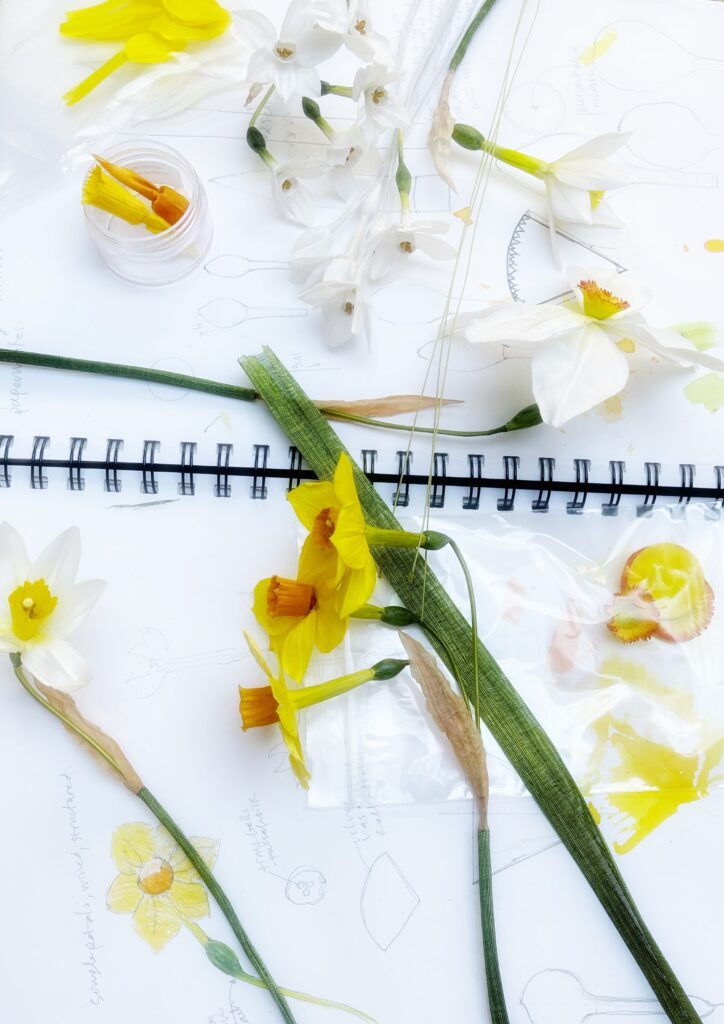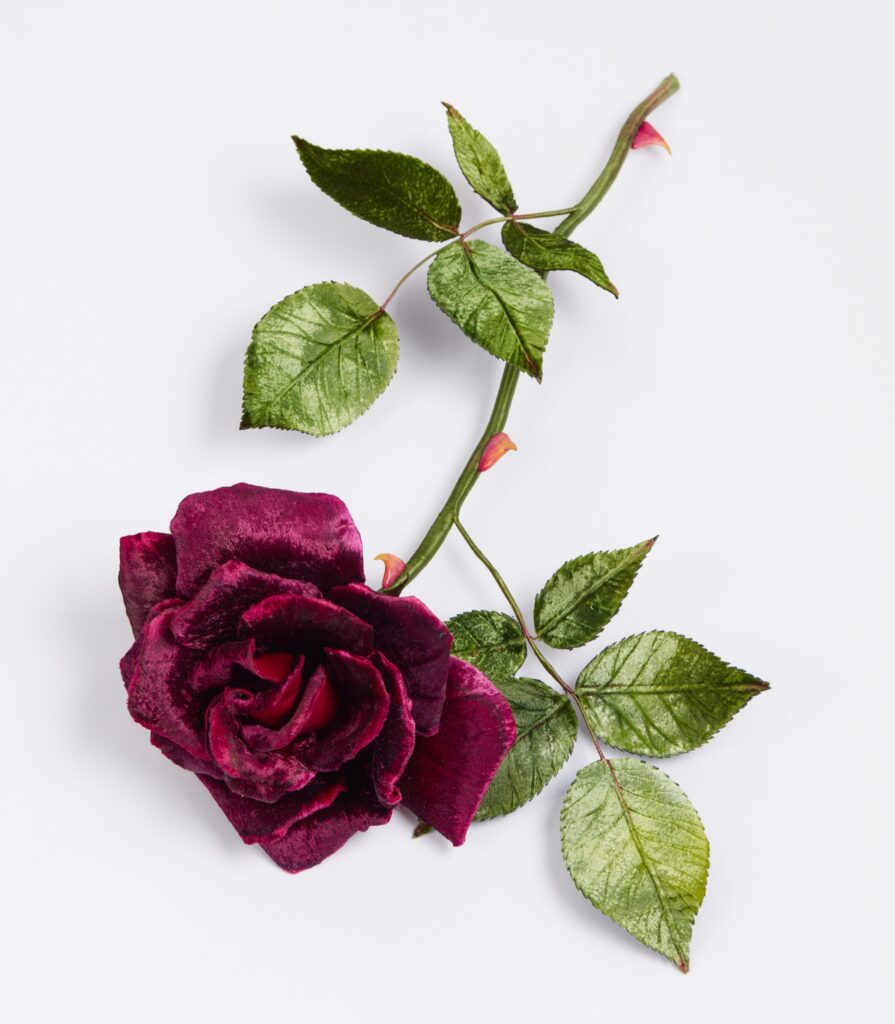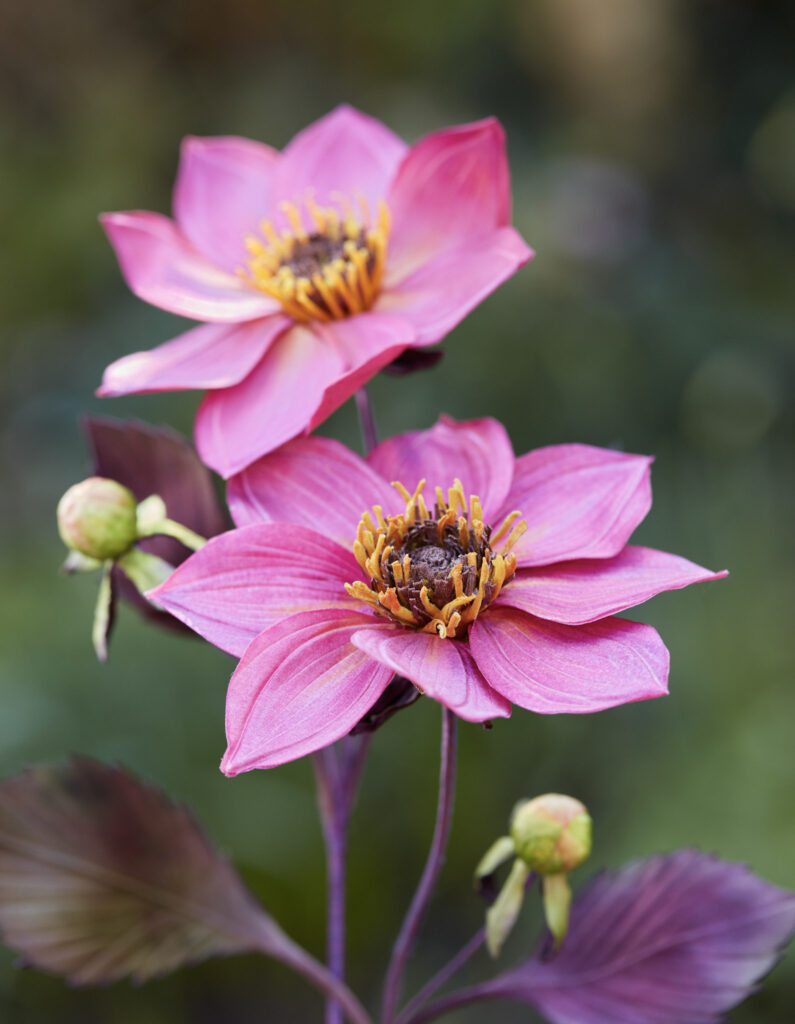Former milliner Anne Tomlin specialises in hand-made flowers, beautifully crafted with an attention to detail in silk and velvet. For our exhibition Wild & Cultivated: Fashioning the Rose, Anne created two roses; one wild, one cultivated. We found out more about how she makes these lifelike works of botanical art:

I started making flowers after being asked to make a hat for the Duchess of Devonshire, a Queen Mary’s toque with a large pink rose, in the early 1990’s. At the time I was under a lot of pressure producing hats for the retail trade, consequently learning how to make flowers became a long process over many years. I was never taught how to make them, and at the time it was hard to find any information on the subject as the flower-making craft and industry had mostly disappeared from the UK in the 1960’s.
I happened to see an article on a Parisian couture flower-making company, Legeron, that inspired me to find out more and I eventually bought some flower-making tools that were advertised in the back of a book, and I started to investigate ways of making. I have a curious nature, love of detail and research, so looking around and putting together a combination of techniques that I see used in other crafts, and studying the structures of flowers, has helped me find my own language. I spent my childhood surrounded by the Somerset countryside, and was inspired by the natural world from an early age.
I went on to study textiles at degree level, this helped with my understanding of colour, texture and form that eventually led to making hats, an obsession that combined my love of textiles with sculpture, basketry and woven fabrics.

Making to an immaculate standard was always my goal and I began making from a very young age, learning to stitch from my grandmother who had an excellent eye for detail, making all of her clothes, from dresses to tailored suits. Today, I draw on the skills I learnt from her, from the weaving of fine silks at college, and from millinery, using hat materials for the sculptural parts of flowers and fine silks for the petals.
It was only after I stepped away from my hat-making business in London and moved to a village close to the South Downs that I was able to experiment and observe nature to a more refined degree. I took time to recover from the hectic world of fashion to study the wild flowers around me, to plant, draw and make the flowers I love.

When I begin making a flower, I prefer to have the actual flower to study. I take it apart, looking at all the components and then decide what is important and what it is that gives that flower its personality and structure. I then make templates, sometimes altering the scale, depending on the project. I use only a few types of silk and find these are versatile enough for all the flowers I make. I collect antique silk and also buy garments from charity shops if the fabric is interesting or the right colour. I first stiffen undyed silk with a solution of PVA alcohol, then cut out the petals. For some flowers I use just one layer of silk, for others I use two layers with wire hidden inside; some have up to a hundred petals for each flower. Each flower is different and every time I make something new, I assess what would best represent it and this is what takes the time. It can take several attempts to get it right and I’m quick to ditch the ones that haven’t worked.

I find working with colour to be instinctive. I use silk dyes to emulate the translucency that I see in nature. I colour each petal as if I am painting with watercolours, layering the dye to build up to richer shades and by doing this I can get the effect of a real petal. I use Japanese flat silk to bind the stems as this gives the look of a fabric rather than of thread. I use glue and stitch when constructing a flower, and paper clay to sculpt parts of flowers such as the ovary of a rose, the seeds of lavender, rose hips or the middle of a daisy. Sometimes I use an embossing technique for the veining of a rose leaf by cutting a lino plate and using heat to transfer the impression. I prefer to make all the parts of the flower by hand, and this gives me the control to make everything to the size, colour and shape that I require.
It was curator Amy de la Haye who asked if I would make the roses for the exhibition Wild & Cultivated: Fashioning the Rose — one wild, one cultivated—after we had magically found each other on Instagram. I already had the framed dog rose, which was perfect for this, and I set about to make a cultivated rose with prickles to contrast with it.
I used silk velvet for this rose to emphasise the deep rich red colour that, to me, has the appearance of velvet. It took many layers of dye to reach to required tone, leaving brighter pink edges for contrast and refraction of light. The petals have a framework of wire and are lined in silk, enabling me to turn the edges over without using flower making tools that would damage the silk pile. The prickles are made from sculpting paper clay and then each one is made smooth with fine sandpaper. I made the leaves using an embossing technique described above.

Making the wild rose was a more delicate affair. I made the stamens by hand, and to get the wonderfully tiny dotty effect, I added a touch of thickened brown dye to each stamen. I covered a tiny ball with velvet for the centre of the rose, sewing the stamens around the base. The petals are made from stiffened silk satin that are wired and backed with a stiffened, finer, silk. They have really delicate colouring, a tiny amount of veining and shaping. The leaves are also made with silk satin, coloured and then the veining is made with an arrow-shaped heated flower tool, with the edges snipped irregularly.
Hovering close-by is a honey bee made from paper clay, velvet, wire, woven wire fabric. Many insects are attracted to the wild rose and play an important part in pollination. I like the challenge of using my skills to make anything in the natural world—flora and fauna.
My favourite flowers are the wild flowers I see on the chalky downs near us, particularly Greater knapweed (Centaurea scabiosa), wild dog roses, and wild carrot (Daucus carota). I am eager to make a wild carrot, which I anticipate being very challenging, but I just love the look of its structure and can’t wait to get stuck in!

I love gardening and have a wildlife garden, where only nature-friendly plants are invited. I have 12 trees, a wild meadow, many roses—including a dog rose that has found its home climbing a plum tree—many flowers and shrubs flowering throughout the year. There’s ivy climbing on the walls, a small pond and piles of wood dotted around; consequently we have plenty of visiting birds, as well as a family of foxes. I have become acutely aware of climate change, the disappearance of wild flowers and the decline of wildlife and believe our gardens should be a sanctuary for nature.
I have been commissioned to write a book about flower-making, documenting my process and explaining the techniques I’ve developed over the years. I’m approaching it as a study of each of the flowers in my garden, as they appear throughout the year, starting with the Snowdrop and finishing with the Dahlia. It is scheduled to be published early next year.

Other than that, I have also been enjoying working with the artist Yinka Shonibare for the past few years making various flowers and plants for his sculptures that highlight the effects of climate change. I am currently making a branch of Aleppo pine to be followed by a bouquet of endangered flowers all of which I haven’t made before. I wonder what life would be like without a challenge? These days I am happy in the knowledge that (almost!) anything is possible to make and my work is playing its part in the education of nature conservation.

—
